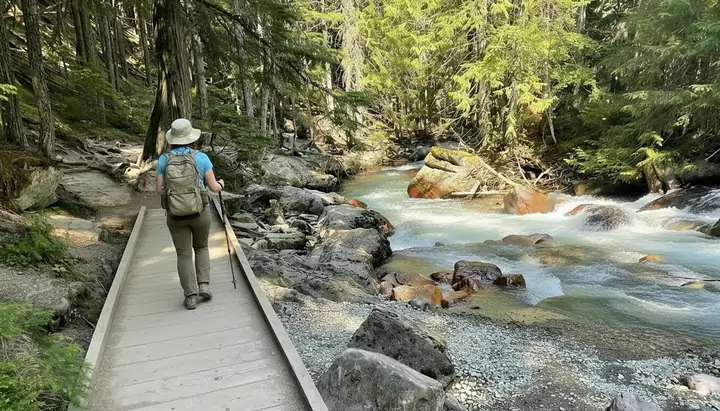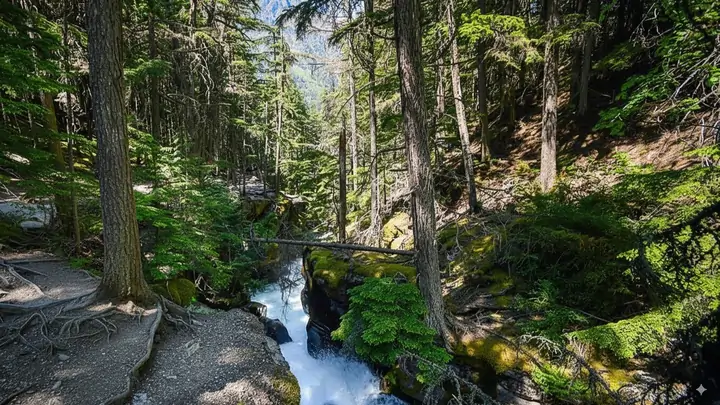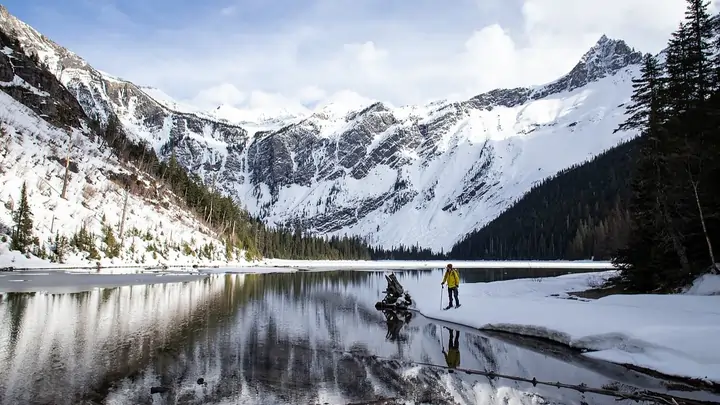If you’re chasing a short, wildly rewarding day hike on Glacier’s west side, the Avalanche Lake trailhead is your golden ticket. Tucked near Lake McDonald, this route blends cathedral-tall cedars, a lively creek, and a bowl of waterfalls pouring into a turquoise lake that doesn’t look real. I’ve done it in both late September and a rainy October—two very different moods, same verdict: absolutely worth it.
Why Avalanche Lake is a Must-See in Glacier National Park

Avalanche Lake punches way above its mileage. You’ll walk through an old-growth forest that stays mostly shaded (a relief on warm afternoons), follow Avalanche Creek as it froths through chasms, and pop out at a glacial cirque rimmed by peaks and multiple falls. Even on a moody, cloudy day, the lake keeps its drama.
Definitely one of the most beautiful hikes I’ve ever done. Reaching the lake at the end of the trail was absolutely worth it. Even on a cloudy day, it’s breathtaking. That moment when the trees open up and the lake comes into view? No photo can do it justice.
How to Get to Avalanche Lake Trailhead
Driving directions from West Glacier / Lake McDonald
From the West Glacier entrance, head toward Lake McDonald on Going-to-the-Sun Road. The Trail of the Cedars loop is your landmark; the Avalanche Lake trailhead branches from there. If you’re staying around Lake McDonald, it’s a short drive to the Avalanche area.
Parking & shuttle options
Parking fills early in summer and on weekends. Arrive before sunrise if you can, or use park shuttle options when operating in peak season.
We got to the park around 5 a.m. and the trail and lake were perfectly calm. By the time we were heading back down, groups of hikers were streaming up nonstop. Starting early really does mean easier parking and a quieter shore.
Guide Map (for quick orientation)

Use the Trail of the Cedars as your gateway. From the boardwalk, follow the clearly signed Avalanche Lake spur. Stay on the main track; there are side paths that can be confusing—keep eyes on signage.
Avalanche Lake Trail Stats: Distance, Elevation & Difficulty
Distance & elevation gain
Expect roughly 4.5 mi / ~7.2 km roundtrip with a steady moderate climb to the lake, and an easy cruise back down.
Average hiking time
Most hikers take 2–3 hours depending on pace, photo stops, and time spent along the lakeshore.
Difficulty
I’d rate it easy-to-moderate for fit hikers; moderate for beginners due to the grade and a few steeper pitches.

I’d rate the hike up to the lake as intermediate—there are some steep sections, and it would be tough to manage with crutches.
What to Expect on the Trail (Step by Step)
Trail of the Cedars
You’ll begin on a flat, family-friendly boardwalk through towering cedar and hemlock. It’s cool, shaded, and photogenic—great warm-up.
Avalanche Creek & waterfalls

As the grade picks up, the path parallels Avalanche Creek with occasional views into blue chutes and small falls. Much of this stretch stays in dense forest; views come in windows rather than constant panoramas.
Reality check: Most of the hike winds through forest, with only occasional views of the creek and surrounding peaks. If you’re expecting constant ridge-top panoramas, set your expectations here.
Final climb to the lake

The last push is the steepest. When the forest finally breaks, you arrive at Avalanche Lake—a glacial amphitheater with multiple cascades streaking the cirque. On calm mornings, reflections can be mirror-clean; after rain, the waterfalls roar.
October memory: It rained nonstop… but it was incredible to see the river surging, the waterfalls pouring down, and the rain dancing on the lake.
Highlights at Avalanche Lake
Monument Falls & surrounding peaks

Multiple ribbons of water tumble from the cirque walls—prime long-lens material. Peaks ring the lake, and the color shifts with light and weather.
Photography tips at the lake
- Early light gives you glassy reflections and fewer footprints on the beach.
- Cloudy/rainy days add mood and texture to waterfalls (bring a microfiber cloth).
- Footnote from the field: “Las fotos que tomé no le hacen justicia.” Spend a few extra minutes; shoot wide and then pick out the falls with a zoom.

Best Time to Hike Avalanche Lake Trail
- Time of day: Early morning wins for parking and solitude. Afternoon can still be pleasant thanks to ample shade. “La mayor parte del sendero está a la sombra… nos vino genial a primera hora de la tarde.”
- Season: Late spring through fall is typical. Late September can be busy but beautiful; October brings fewer people and moodier weather—pack layers and rain protection.
- Weather flex: The lake shines in sun or cloud. After storms, creek and waterfalls surge.

NEW: Quick Planner by Season & Crowd Strategy
| Season (typical) | Trail Conditions & Vibe | Best Hours | If Parking Is Full (Alternatives) |
|---|---|---|---|
| Late Spring (May–June) | Snowmelt, lively creek, cool temps; possible muddy spots | Early AM for quiet, late PM for shade | Use park shuttle (if operating); do Trail of the Cedars loop; check Johns Lake Loop nearby |
| Summer (July–Aug) | Peak crowds, warm, stable weather; shade helps | Pre-sunrise arrival strongly recommended | Shuttle; wait for turnover ~late morning; consider Lake McDonald shoreline walks |
| Early Fall (Sept) | Crisp air, busy weekends, golden light | Early AM weekdays | Shuttle; Johns Lake Loop; short Apgar area strolls |
| Mid–Late Fall (Oct) | Fewer people, changeable weather, moody waterfalls | Late morning windows between storms | If shuttles reduced: loop Trail of the Cedars; explore Apgar Village trails |

Wildlife, Safety & Bear Awareness
You’re in bear country (both black and grizzly). Carry bear spray, know how to use it, make noise in blind curves, and keep your distance from wildlife.
Field sighting: I spotted a bear, a moose, a deer, and even a Steller’s jay. Amazing—but safety first.
Other basics: stay on trail (there are spur paths; don’t be tempted to cut), give others space at narrow sections, and watch your footing on roots and wet rocks.

Practical Tips for Hiking Avalanche Lake Trailhead
- Water & snacks: Bring at least 1–2 liters and something salty/sweet.
- Footing: It’s a well-trodden path with roots and occasional mud. Lightweight hikers or trail runners are perfect.
- Restrooms: You may see a toilet near the trailhead/parking depending on seasonal ops. Personal recollection: “No recuerdo que tuviera baños, pero en el mapa decía que había uno.”
- Swimming: The water is frigid and often silty. Wading at the shore is common; full swims are rare. “No se puede nadar, el agua está demasiado turbia, pero conseguí fotos magníficas.”
- Crowds: This is one of Glacier’s most popular hikes. Start early for a quieter experience.
- Navigation: Stick to the signed main path and the Trail of the Cedars approach. “Ve con ojos”—there are side tracks; don’t drift off the main spur to the lake.
FAQs About Avalanche Lake Trail
How long is the hike?
About 4.5 mi / ~7.2 km roundtrip.
Where exactly is the Avalanche Lake trailhead?
On Glacier’s west side near Lake McDonald, branching from Trail of the Cedars.
Is it difficult?
Generally easy-to-moderate with steady uphill to the lake and downhill back.
What’s the best time to go?
Early morning for parking and quiet shores; shoulder seasons (late Sept/Oct) can be lovely with fewer people—just plan for variable weather.
Are there bears?
Yes. Carry bear spray, make noise, and give wildlife space.
Can you swim in Avalanche Lake?
It’s very cold and often silty; most people wade at the shoreline rather than swim.
Are there restrooms?
Availability can vary by season/area near the parking. Check the latest park info or map at the trailhead.
Is it kid-friendly?
Many families hike it; the steady grade can feel moderate for little legs. Turn around anytime—you’ll still get a great forest-and-creek experience.
Can I bring my dog?
Glacier National Park has strict pet rules on trails. Check current regulations before you go.
Conclusion
The Avalanche Lake trailhead delivers a lot for a half-day: cool shade, a lively creek, and a finale that stops you in your tracks. For me, early starts brought calm water and open beaches; rainy days turned the cirque into a symphony of waterfalls. Either way, the payoff is huge for the effort—just go prepared, start early, and give yourself time at the lake.

